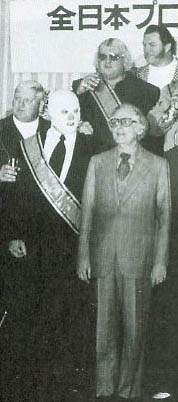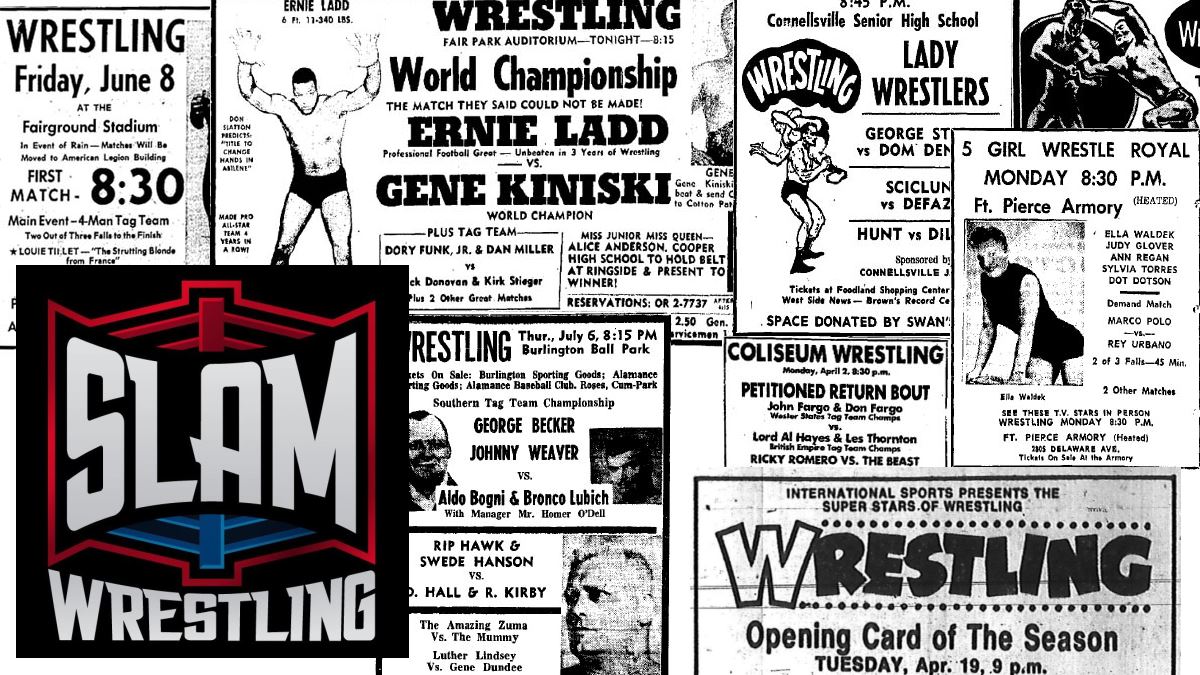In April 2001, Jim Barnett was asked to look back at his long, behind-the-scenes career in pro wrestling and determine the highlight. It didn’t take him long to respond: Australia.
There had been wrestling in Australia off and on since the beginning of the 1900s, but the matches were often the main event of a show with a boxing undercard. But it was Barnett and partner Johnny Doyle who came along and married pro wrestling up with its natural suitor, Television.

Jim Barnett (in glasses) in Japan in 1973 with Dusty Rhodes & Don Leo Jonathon (back row) and Dick Murdoch, far left. – courtesy Mike Lano, wrealano@aol.com
“I took a country that had never had wrestling and I went for six months and stayed for 10 years and did very well. I had all the top American wrestlers there, so I would say that was one of my highlights,” Barnett told SLAM! Wrestling three and a half years ago.
Doyle had a friend who had been involved in pro wrestling in California at the old Hollywood Stadium who had relocated to Australia and married a local. “He had called many times telling us that Australia had never had a television show that was nationwide on the channels there,” Barnett said. With his experience with various promotions, especially from the television end, it was natural for Barnett to be intrigued by the opportunity.
Barnett and Doyle went over to Sydney, Australia in 1964, “to see what it was like and talk to the people.” They would return later that year, presenting the first card of World Championship Wrestling on October 23, 1964 at the Sydney Stadium.
The promotion took off, and the key was the television slot on Australia’s strongest station, Channel 9 – noon on Saturdays and Sundays. Eventually, Barnett would score WCW television time in New Zealand, and see the show head out on tape to Hong Kong and all through southeast Asia. (Barnett also tried roller derby in Australia.)
“When [Barnett] first went over there to make arrangements, he cut the big television company in on the promotion. They coverage they had was unbelievable. Shoot, when we did the TV program, it was on a super time,” recalled Archie “The Mongolian Stomper” Gouldie, who did three tours of Australia for Barnett.
The regular live shows across Australia – no longer married to boxing undercards – meant that local Australian talent like George Barnes, Ron Miller, Larry O’Dea, and Johnny Boyd, began to work on a steady basis.
Because of his experience promoting in the United States, Barnett had the connections to line up the big-name international wrestlers. He quickly figured out that there was a real, tangible benefit with using wrestlers from the British Commonwealth – they didn’t have to pay Australian taxes at the same rate as non-Commonwealth members. “Americans after about six weeks had to start having so much money withheld from their salaries, whereas the Canadians didn’t,” Barnett said.
Imported stars included Killer Kowalski, Ray Stevens, King Curtis Iaukea, Dominic Denucci, Mark Lewin, Mario Milano, Billy Robinson, Spiros Arion, Karl Gotch, Bruno Sammartino, Pepper Gomez, Gorilla Monsoon, Brute Bernard, Skull Murphy and many others.
Some of the stars just fell in love with the country. “My first trip to Australia, I was there one whole year,” said Killer Kowalski. “That was when I was world’s champion. Then I left, and every six months, I came back, stayed six months. My first time there was in ’65, and my last show there was about in ’73.”
“The people were friendly and it was kind of a different attitude. We just had a great time out there,” recalled George Scott, who was there 6-1/2 months with his brother Sandy.
According to Goudie, the negotiation with Barnett about an Australian tour never included much of a time commitment: “He’d mention two or three months, but he didn’t hold nobody to that. There was no written contract or anything, but most people did stay over there for two or three months, some of them than that ’cause business was good, the money was good. Beautiful country.”
The two partners, Barnett and Doyle, would split their time in Australia, with one there for six months, then the other. In an interview in the Whatever Happened To … newsletter in 1997, Killer Karl Kox explained the difference. “When Doyle was there, business was terrible, because he didn’t want any heat. The business really jumped up when Barnett got there because he let all the guys do what they wanted. That’s why he was so successful in Australia. He booked good talent in there with good ideas.”
Gouldie agreed. “[Barnett] was a fantastic businessman, but he knew what would draw money. But he always had a smart booker. If he didn’t like what the booker was doing, he’d change. He knew what to do, how to draw money.”
As a land of immigrants, Australia required a specific type of hero. “They were good fans,” Gouldie said. “Australia has a lot of Italians, people from different countries. Of course, Jim was smart. He always had an Italian on the card.”
“Greeks especially were popular in Melbourne. They had to be from Greece. They had to be able to speak Greek. [In] Brisbane and Perth and Adelaide, nationality groups were not important. It was just in Sydney and Melbourne,” Barnett said.
The size of the territory meant that you had to fly everywhere. Barnett explained the route. “Melbourne was a very good town for us, although we lived in Sydney, we did Melbourne on Saturday nights, Melbourne TV Sunday mornings, and flew to Perth on Monday, Adelaide on Tuesday, Brisbane on Wednesday, Brisbane television on Thursday, Sydney on Friday, Sydney television on Saturday morning, Melbourne on Saturday night and then Melbourne television on Sunday morning.” Wrestlers were required to dress well on the plane and refrain from drinking.
In 1969, Johnny Doyle died, and Barnett took over the whole promotion himself, running it until 1974.
“We did tremendous business up until the last year,” Barnett said. “It began to tail off. They changed governments, they had had a very, sort of Republican government and then suddenly they got a Labour government and they wanted all American promoters to have Australian partners. Sort of like the Nazis did with the Jews. I did get two Australian young guys, gave them five per cent each.”
Barnett got the opportunity to buy the Atlanta promotion. “I thought that if there was a chance to get out, I’d get out and I got out in ’74, actually the end of ’73 and bought the Atlanta thing,” he said, explaining that he bought 38 per cent of the promotion for $268,000. “I paid cash … now no one buys promotions, they just take them.”
World Championship Wrestling continued on, run by Tony Kolonie, until 1978, when Channel 9 cancelled the show. In its essay, Australian Professional Wrestling: A Short History, the WWA blamed rising production costs and the invention of World Series Cricket for the sudden ending of television wrestling.
To this day, when wrestlers and fans refer to Australian wrestling and its glory days, it is the World Championship Wrestling promotion of Barnett and Doyle that they are referring to. With Barnett’s death on September 18, 2004, at age 80 from cancer and pneumonia, that last direct link to the glory days is gone.
RELATED LINK

